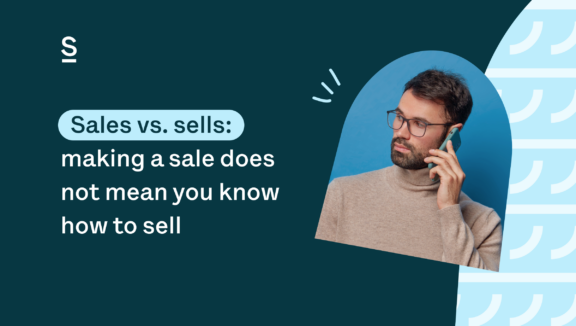Sale vs sell: making a sale does not mean you know how to sell

There’s a huge difference between sale vs sell that all salespeople should be conscious of.
One is accomplished using a specific skill set, focusing on customers’ needs and putting in hard work (selling). The other (sales) is often based on luck or happenstance.
This article will dig into sale vs sell, a guide on exactly what you need to know to sell better and more frequently and why sales are often determined by external factors.
It’s better and more beneficial for your company to focus on selling instead of sales – and here’s why.
Sale vs. sell
Let’s take a look at the difference in definition of sale vs sell. According to Oxford, the word ‘sale’ is defined as, “the exchange of a commodity for money; the action of selling something.” But really, a sale doesn’t always occur because of a selling action as the official definition insinuates. A sale is a result, or a transaction that might occur because of selling, but also might happen because of luck, chance, or external factors.
Oxford refers to the word ‘sell’ as “give or hand over (something) in exchange for money,” or, “persuade someone of the merits of.” We prefer to focus on the latter definition because selling is about action. Selling is teamwork, planning, organization, time, dedication, and research. Selling is all about the how – a process that needs to be finessed, prioritized, and learned.
The sale is just the end game. And really, the best ending is always reached after putting in the hard work by selling the right way: in the race of sale vs sell slow and steady wins the race.
So, what leads to a sale, anyway?
Sales can often be attributed to external factors. A sale is a single action – and if you want repeat sales, getting better at selling can help (but more on that later).
When it comes to sales, many things can lead to a sale: a need, a want, marketing, or beyond. But sales often happen because customers need something quickly and make an impulse buy.
Sales that aren’t based on dedicated, curated selling processes can often result in unhappy customers and definitely won’t generate repeat sales, recommendations, or positive reviews.
A rushed sale without the proper selling techniques or business relationships can create customer churn, as customers realize they didn’t dig deep enough and weren’t properly guided through the purchasing process. The product sold may not be the right fit for them.
A high customer churn rate is a clue that your team is focused on sale vs sell, and that means it’s time to get back to the basics and re-learn (or learn for the first time) how to sell.
Salespeople, if you’ve had a new sale, ask yourself these questions
So you’ve had a sale. Great! But was it a quality sale? Was it a worthwhile sale? Did you start off with a quality prospect? Have you generated a repeat customer? What about customer churn? Did you put in the work and create a meaningful business relationship? Did you follow up? Will your customer write you and your company a rave review and recommend you to others? Have you considered using Surfe?
Nothing in life is free, and this advice applies to sales. If you didn’t put in the work, this wasn’t a quality sale, and it’s time to change focus and think more about selling the right way.
How to be a good seller
Being a good seller is about many things, not limited to but including teamwork, strategy, focus, and hard work. It’s not just about the end goal or the result (the sale).
That’s why it’s not the right plan to simply consider the sale. The key focal point needs to be on selling and the ways your company approaches selling.
The entire process of moving a lead down the pipeline the right way, turning a lead or prospect into a customer, and showing your client the value proposition of whatever you’re selling and how it can help their individual pain point(s) is what creates a quality business relationship. Skip the scripted approach and curate a personal plan apt for your customer and be able to improvise when needed.
Once you’ve formed a quality business relationship, treat your client in a personal manner after working hard to do the research to solve their particular issues. Make sure to listen carefully to their queries and follow up with responses in proper and professional ways. And speaking of following up, this is an important step you should never forget to do during the selling process.
Selling the right way and forming important B2B and B2C relationships may mean you have lifelong clients and business relationships on your hands. And that’s actually what you want – because these relationships, formed thanks to due process, end in the sales that really count.
This is what makes a good seller: differentiating between making a quick sale vs sell or ensuring that both parties are a good fit for one another before closing a deal.

Connect your CRM with LinkedIn in 60 seconds.
Surfe makes outbound sale vs sell efforts seamless by ensuring you never copy and paste into your CRM again. No more switching tabs, no more bounced emails. Loads more time to focus on what really matters: closing deals.
Forget that quick sale: knowing how to sell will increase your ROI
Selling is about forming business relationships that can result in many sales, not just one sale. Decreasing your percentage of customer churn by creating a selling process that hooks repeat customers will end in positive reviews, repeat sales, and recommendations to others that may help you gain new clients (and yes, ending in more sales from more repeat clients!). Likewise, bad reviews from unhappy clients and frequent customer churn due to quick sales may actually harm your business. Learned everything you needed to know about sale vs sell?
According to HubSpot, decreasing your churn rate by 10% could add additional thousands in revenue to your company. When it comes to sale vs. sell, instead of just going after that easy sale, put in the hard work, which will get you those repeat customers and increase your ROI.
Knowing how to sell means you may actually lose a sale or two that wasn’t meant to be, but it’s what’s best for the company anyway, as quality selling over quantity of sales is what really counts and increases that bottom line.


